安徽省安庆市五校联盟2015届高三下学期3月联考英语试题word版含答案
- 格式:doc
- 大小:296.00 KB
- 文档页数:14
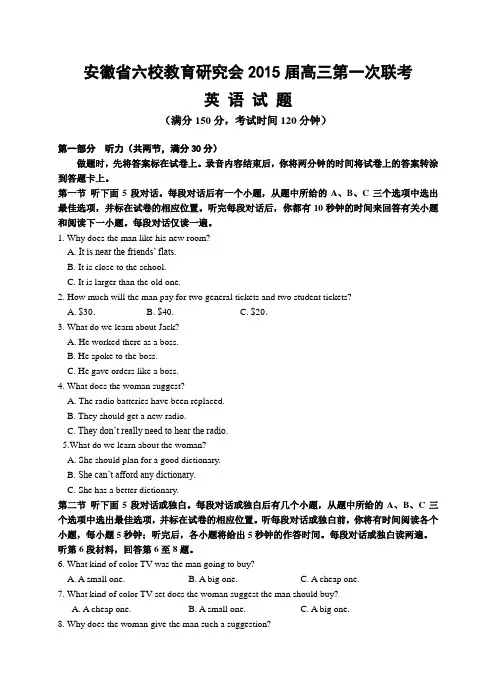
安徽省六校教育研究会2015届高三第一次联考英语试题(满分150分,考试时间120分钟)第一部分听力(共两节,满分30分)做题时,先将答案标在试卷上。
录音内容结束后,你将两分钟的时间将试卷上的答案转涂到答题卡上。
第一节听下面5段对话。
每段对话后有一个小题,从题中所给的A、B、C三个选项中选出最佳选项,并标在试卷的相应位置。
听完每段对话后,你都有10秒钟的时间来回答有关小题和阅读下一小题。
每段对话仅读一遍。
1. Why does the man like his new room?A. It is near the friends’ flats.B. It is close to the school.C. It is larger than the old one.2. How much will the man pay for two general tickets and two student tickets?A. $30.B. $40.C. $20.3. What do we learn about Jack?A. He worked there as a boss.B. He spoke to the boss.C. He gave orders like a boss.4. What does the woman suggest?A. The radio batteries have been replaced.B. They should get a new radio.C. They don’t really need to hear the radio.5.What do we learn about the woman?A. She should plan for a good dictionary.B. She can’t afford any dictionary.C. She has a better dictionary.第二节听下面5段对话或独白。
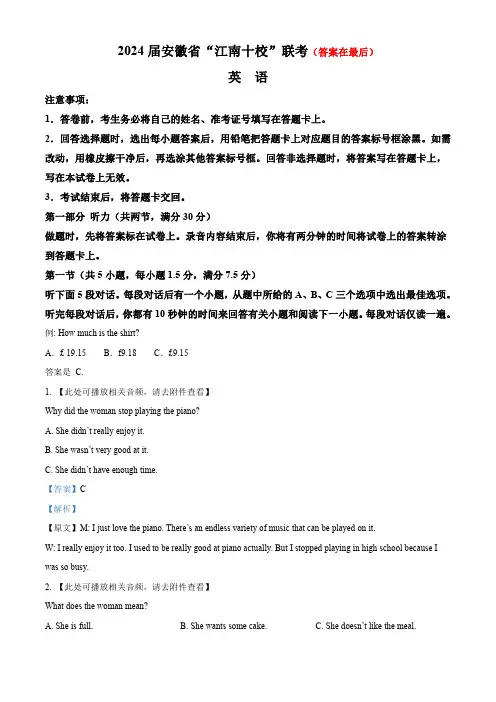
2024届安徽省“江南十校”联考(答案在最后)英语注意事项:1.答卷前,考生务必将自己的姓名、准考证号填写在答题卡上。
2.回答选择题时,选出每小题答案后,用铅笔把答题卡上对应题目的答案标号框涂黑。
如需改动,用橡皮擦干净后,再选涂其他答案标号框。
回答非选择题时,将答案写在答题卡上,写在本试卷上无效。
3.考试结束后,将答题卡交回。
第一部分听力(共两节,满分30分)做题时,先将答案标在试卷上。
录音内容结束后,你将有两分钟的时间将试卷上的答案转涂到答题卡上。
第一节(共5小题,每小题1.5分,满分7.5分)听下面5段对话。
每段对话后有一个小题,从题中所给的A、B、C三个选项中选出最佳选项。
听完每段对话后,你都有10秒钟的时间来回答有关小题和阅读下一小题。
每段对话仅读一遍。
例:How much is the shirt?A.£19.15B.f9.18C.£9.15答案是 C.1.【此处可播放相关音频,请去附件查看】Why did the woman stop playing the piano?A.She didn’t really enjoy it.B.She wasn’t very good at it.C.She didn’t have enough time.【答案】C【解析】【原文】M:I just love the piano.There’s an endless variety of music that can be played on it.W:I really enjoy it too.I used to be really good at piano actually.But I stopped playing in high school because I was so busy.2.【此处可播放相关音频,请去附件查看】What does the woman mean?A.She is full.B.She wants some cake.C.She doesn’t like the meal.【答案】A【解析】【原文】M:Can I offer you another piece of cake?W:Thank you.If I had it,I would burst.It’s nice of you to prepare this meal for me.M:Great.As long as you enjoyed it.3.【此处可播放相关音频,请去附件查看】What is the relationship between the speakers?A.Teacher and student.B.Doctor and patient.C.Husband and wife.【答案】B【解析】【原文】W:So,tell me sir,when did you first notice the problem with your leg?I will examine it later.M:I was at a restaurant with my wife and friends about three weeks ago.I suddenly felt a sharp pain.4.【此处可播放相关音频,请去附件查看】What time is it?A.9:30a.m.B.10:00a.m.C.10:30a.m.【答案】C【解析】【原文】W:George,where have you been?You said nine o’clock.I’ve been waiting here for an hour and a half since then.M:I’m really sorry,Jenny.I set off at eight this morning,and would you believe I’ve been stuck in traffic?5.【此处可播放相关音频,请去附件查看】How will the woman probably go to the airport?A.By taxi.B.By train.C.By bus.【答案】A【解析】【原文】W:Do you know if the last bus has gone?M:I’m afraid it left a couple of minutes ago.W:Oh no!Do you know where I can get a taxi to the airport?M:You can go to the Red Star Square near the railway station.There are usually a few taxis there.第二节(共15小题;每小题1.5分,满分22.5分)听下面5段对话或独白。
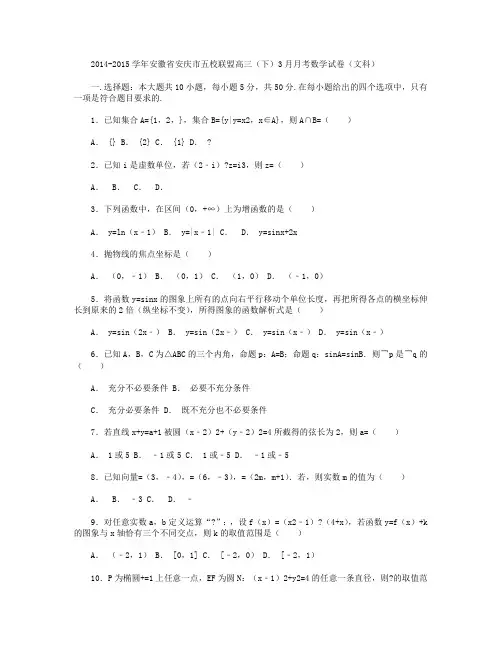
2014-2015学年安徽省安庆市五校联盟高三(下)3月月考数学试卷(文科) 一.选择题:本大题共10小题,每小题5分,共50分.在每小题给出的四个选项中,只有一项是符合题目要求的. 1.已知集合A={1,2,},集合B={y|y=x2,x∈A},则A∩B=( ) A. {} B. {2} C. {1} D. ? 2.已知i是虚数单位,若(2﹣i)?z=i3,则z=( ) A. B. C. D. 3.下列函数中,在区间(0,+∞)上为增函数的是( ) A. y=ln(x﹣1) B. y=|x﹣1| C. D. y=sinx+2x 4.抛物线的焦点坐标是( ) A.(0,﹣1) B.(0,1) C.(1,0) D.(﹣1,0) 5.将函数y=sinx的图象上所有的点向右平行移动个单位长度,再把所得各点的横坐标伸长到原来的2倍(纵坐标不变),所得图象的函数解析式是( ) A. y=sin(2x﹣) B. y=sin(2x﹣) C. y=sin(x﹣) D. y=sin(x﹣) 6.已知A,B,C为△ABC的三个内角,命题p:A=B;命题q:sinA=sinB.则¬p是¬q的( ) A.充分不必要条件 B.必要不充分条件 C.充分必要条件 D.既不充分也不必要条件 7.若直线x+y=a+1被圆(x﹣2)2+(y﹣2)2=4所截得的弦长为2,则a=( ) A. 1或5 B.﹣1或5 C. 1或﹣5 D.﹣1或﹣5 8.已知向量=(3,﹣4),=(6,﹣3),=(2m,m+1).若,则实数m的值为( ) A. B.﹣3 C. D.﹣ 9.对任意实数a,b定义运算“?”:,设f(x)=(x2﹣1)?(4+x),若函数y=f(x)+k 的图象与x轴恰有三个不同交点,则k的取值范围是( ) A.(﹣2,1) B. [0,1] C. [﹣2,0) D. [﹣2,1) 10.P为椭圆+=1上任意一点,EF为圆N:(x﹣1)2+y2=4的任意一条直径,则?的取值范围是( ) A. [0,15] B. [5,15] C. [5,21] D.(5,21) 二.填空题:本大题共5小题,每小题5分,共25分.把答案填在答题卡的相应位置. 11.已知直线l1:ax+2y+6=0,l2:x+(a﹣1)y+a2﹣1=0,若l1⊥l2,则a=. 12.已知a>0,b>0,且点(a,b)在直线x+y=2上,则2a+2b的最小值为 . 13.设m>1,在约束条件下,目标函数z=x+my的最大值等于2,则m=. 14.已知sinθ﹣cosθ=,θ∈(0,π),则tanθ=. 15.若函数f(x)=x3+a|x﹣1|在[0,+∞)上单调递增,则实数a的取值范围是 . 三.解答题:本大题共6小题,共75分.解答应写出文字说明、证明过程或演算步骤.解答写在答题卡上的指定区域内. 16.(12分)(2015春?安庆月考)设向量=(sin2x,sin),=(cos,﹣cos2x),f(x)=?. (1)求f(x)的最小正周期; (2)求f(x)在区间[0,π]上的单调递减区间. 17.(12分)(2015春?安庆月考)公差d>0的等差数列{an}中,a1=2,a1、a2、a4成等比数列; (1)求数列{an}的通项公式; (2)数列{bn}满足an=+++…+,求数列{bn}的通项公式. 18.(12分)(2014春?芜湖期末)△ABC中内角A、B、C的对边分别为a、b、c,且2acosC=2b ﹣c. (Ⅰ)求角A的大小; (Ⅱ)如果a=1,求b+c的取值范围. 19.(13分)(2015春?哈尔滨校级期中)已知函数f(x)=lnx﹣ax,其中a>0. (1)当a=1时,求f(x)在[1,e]上的最大值; (2)若1≤x≤e时,函数f(x)的最大值为﹣4,求函数f(x)的表达式. 20.(13分)(2015春?安庆月考)已知数列{an}的前n项和为Sn,a1=1,an+1=2Sn+1(n∈N*). (1)求数列{an}的通项公式; (2)求数列{}的前n项和Tn. 21.(13分)(2012?长春模拟)如图,椭圆经过点(0,1),离心率. (l)求椭圆C的方程; (2)设直线x=my+1与椭圆C交于A,B两点,点A关于x轴的对称点为A′(A′与B不重合),则直线A′B与x轴是否交于一个定点?若是,请写出定点坐标,并证明你的结论;若不是,请说明理由. 2014-2015学年安徽省安庆市五校联盟高三(下)3月月考数学试卷(文科) 参考答案与试题解析 一.选择题:本大题共10小题,每小题5分,共50分.在每小题给出的四个选项中,只有一项是符合题目要求的. 1.已知集合A={1,2,},集合B={y|y=x2,x∈A},则A∩B=( ) A. {} B. {2} C. {1} D. ? 考点:交集及其运算. 专题:集合. 分析:将A中的元素代入集合B中的等式中求出y的值,确定出B,求出A与B的交集即可. 解答:解:当x=1时,y=1;当x=2时,y=4;当x=时,y=, ∴B={1,4,}, ∴A∩B={1}. 故选:C. 点评:此题考查了交集及其运算,熟练掌握交集的定义是解本题的关键. 2.已知i是虚数单位,若(2﹣i)?z=i3,则z=( ) A. B. C. D. 考点:复数代数形式的乘除运算. 专题:计算题. 分析:利用复数的运算法则和共轭复数的意义,即可得出. 解答:解:∵(2﹣i)?z=i3,∴(2+i)(2﹣i)z=﹣i(2+i),5z=﹣2i+1, ∴z=, 故选:A. 点评:本题考查了复数的运算法则和共轭复数的意义,属于基础题. 3.下列函数中,在区间(0,+∞)上为增函数的是( ) A. y=ln(x﹣1) B. y=|x﹣1| C. D. y=sinx+2x 考点:函数单调性的判断与证明. 专题:函数的性质及应用. 分析:结合对数函数,指数函数,三角函数的图象及性质,分别对各个选项进行判断,从而得出答案. 解答:解:对于A:定义域是(1,+∞),∴y=ln(x﹣1)在(1,+∞)递增, 对于B:y=|x﹣1|在(0,1)递减,在(1,+∞)递增, 对于C:y=在(0,+∞)递减, 对于D:y'=cosx+2>0,所以y=sinx+2x在区间(0,+∞)上为增函数, 故选:D. 点评:本题考查了函数的单调性问题,考查了对数函数,指数函数,三角函数的性质,是一道基础题. 4.抛物线的焦点坐标是( ) A.(0,﹣1) B.(0,1) C.(1,0) D.(﹣1,0) 考点:抛物线的简单性质. 专题:计算题. 分析:把抛物线的方程化为标准方程,求出 p值和开口方向,从而写出焦点坐标. 解答:解:抛物线的标准方程为 x2=﹣4y,开口向下, p=2,=1,故焦点为(0,﹣1), 故选 A. 点评:本题考查抛物线的标准方程,以及简单性质的应用. 5.将函数y=sinx的图象上所有的点向右平行移动个单位长度,再把所得各点的横坐标伸长到原来的2倍(纵坐标不变),所得图象的函数解析式是( ) A. y=sin(2x﹣) B. y=sin(2x﹣) C. y=sin(x﹣) D. y=sin(x﹣) 考点:函数y=Asin(ωx+φ)的图象变换. 专题:分析法. 分析:先根据左加右减进行左右平移,然后根据横坐标伸长到原来的2倍时w变为原来的倍进行横向变换. 解答:解:将函数y=sinx的图象上所有的点向右平行移动个单位长度,所得函数图象的解析式为y=sin(x﹣) 再把所得各点的横坐标伸长到原来的2倍(纵坐标不变),所得图象的函数解析式是y=sin (x﹣). 故选C. 点评:本题主要考查三角函数的平移变换.平移的原则是左加右减、上加下减. 6.已知A,B,C为△ABC的三个内角,命题p:A=B;命题q:sinA=sinB.则¬p是¬q的( ) A.充分不必要条件 B.必要不充分条件 C.充分必要条件 D.既不充分也不必要条件 考点:必要条件、充分条件与充要条件的判断. 专题:简易逻辑. 分析: A,B,C为△ABC的三个内角,A=B?sinA=sinB,继而得到p是q的充分必要条件,所以¬p是¬q的充分必要条件.问题得以解决. 解答:解:∵A,B,C为△ABC的三个内角,A=B?sinA=sinB, ∴p?q,q?p, ∴p是q的充分必要条件, ∴¬p是¬q的充分必要条件. 故选:C. 点评:本题以三角形为载体,考查命题充要条件的意义和判断方法,属基础题. 7.若直线x+y=a+1被圆(x﹣2)2+(y﹣2)2=4所截得的弦长为2,则a=( ) A. 1或5 B.﹣1或5 C. 1或﹣5 D.﹣1或﹣5 考点:直线与圆相交的性质. 专题:直线与圆. 分析:由已知求出圆心到直线的距离,再由点到直线的距离公式列式求得a的值. 解答:解:∵直线x+y=a+1被圆(x﹣2)2+(y﹣2)2=4所截得的弦长为2, ∴圆心(2,2)到直线x+y﹣a﹣1=0的距离为d=. 由点到直线的距离公式得:,解得:a=1或5. 故选:A. 点评:本题考查直线和圆的位置关系,考查了点到直线的距离公式的应用,是基础的计算题. 8.已知向量=(3,﹣4),=(6,﹣3),=(2m,m+1).若,则实数m的值为( ) A. B.﹣3 C. D.﹣ 考点:平行向量与共线向量;平面向量的坐标运算. 专题:平面向量及应用. 分析:先求得得==(3,1),再由,则这两个向量的坐标对应成比例,解方程求得实数m 的值,可得结论. 解答:解:由题意可得==(3,1),若, 则这两个向量的坐标对应成比例,即, 解得m=﹣3, 故选:B. 点评:本题主要考查两个向量共线的性质,两个向量坐标形式的运算,属于基础题. 9.对任意实数a,b定义运算“?”:,设f(x)=(x2﹣1)?(4+x),若函数y=f(x)+k 的图象与x轴恰有三个不同交点,则k的取值范围是( ) A.(﹣2,1) B. [0,1] C. [﹣2,0) D. [﹣2,1) 考点:根的存在性及根的个数判断. 专题:函数的性质及应用. 分析:化简函数f(x)的解析式,作出函数y=f(x)的图象,由题意可得,函数y=f (x)与y=﹣k的图象有3个交点,结合图象求得结果.. 解答:解:当(x2﹣1)﹣(x+4)<1时,f(x)=x2﹣1,(﹣2<x<3), 当(x2﹣1)﹣(x+4)≥1时,f(x)=x+4,(x≥3或x≤﹣2), 函数y=f(x)=的图象如图所示: 由图象得:﹣2≤k<1,函数y=f(x)与y=﹣k的图象有3个交点, 即函数y=f(x)+k的图象与x轴恰有三个公共点; 故答案选:D. 点评:本题主要考查根据函数的解析式作出函数的图象,体现了化归与转化、数形结合的数学思想,属于基础题. 10.P为椭圆+=1上任意一点,EF为圆N:(x﹣1)2+y2=4的任意一条直径,则?的取值范围是( ) A. [0,15] B. [5,15] C. [5,21] D.(5,21) 考点:椭圆的简单性质. 专题:圆锥曲线的定义、性质与方程. 分析:利用=﹣化简可知?=﹣4,通过a﹣c≤||≤a+c,计算即得结论. 解答:解:?=(+)?(+)=(+)?(﹣)=﹣=﹣4, ∵a﹣c≤||≤a+c,即3≤||≤5, ∴?的范围是[5,21], 故选:C. 点评:本题考查椭圆的简单性质,注意解题方法的积累,属于中档题. 二.填空题:本大题共5小题,每小题5分,共25分.把答案填在答题卡的相应位置. 11.已知直线l1:ax+2y+6=0,l2:x+(a﹣1)y+a2﹣1=0,若l1⊥l2,则a=. 考点:直线的一般式方程与直线的垂直关系. 专题:直线与圆. 分析:由两直线互相垂直,可得两直线系数间的关系,由此列关于a的方程求得a值. 解答:解:∵直线l1:ax+2y+6=0,l2:x+(a﹣1)y+a2﹣1=0,且l1⊥l2, ∴a×1+2(a﹣1)=0,即a+2a﹣2=0,解得a=. 故答案为:. 点评:本题考查了直线的一般式方程与直线垂直间的关系,关键是对垂直条件的记忆与应用,是基础题. 12.已知a>0,b>0,且点(a,b)在直线x+y=2上,则2a+2b的最小值为 4 . 考点:基本不等式. 专题:不等式的解法及应用. 分析:点(a,b)在直线x+y=2上,可得a+b=2.再利用基本不等式的性质、指数运算性质即可得出. 解答:解:∵点(a,b)在直线x+y=2上,∴a+b=2. 又a>0,b>0, 则2a+2b≥2=2=2=4,当且仅当a=b=1时取等号. ∴2a+2b的最小值为最小值为4. 故答案为:4. 点评:本题考查了基本不等式的性质、指数运算性质,考查了推理能力与计算能力,属于中档题. 13.设m>1,在约束条件下,目标函数z=x+my的最大值等于2,则m=. 考点:简单线性规划. 专题:不等式的解法及应用. 分析:根据m>1,可以判断直线y=mx的倾斜角位于区间()上,由此判断出满足约束条件件的平面区域的形状,再根据目标函数z=x+my对应的直线与直线y=mx垂直,且在直线y=mx 与直线x+y=1交点处取得最大值,由此可得关于m的方程,从而求得m值. 解答:解:∵m>1,由约束条件作出可行域如图, 直线y=mx与直线x+y=1交于(), 目标函数z=x+my对应的直线与直线y=mx垂直,且在()处取得最大值, 由题意可知,又∵m>1,解得m=1+. 故答案为:1+. 点评:本题考查的知识点是简单线性规划的应用,其中根据平面直线方程判断出目标函数z=x+my对应的直线与直线y=mx垂直,且在()点取得最大值,并由此列出关于m的方程是解答本题的关键,是中档题. 14.已知sinθ﹣cosθ=,θ∈(0,π),则tanθ=. 考点:同角三角函数基本关系的运用. 专题:三角函数的求值. 分析:把已知等式两边平方,利用完全平方公式及同角三角函数间基本关系化简,求出sin θ+cosθ的值,与已知等式联立求出sinθ与cosθ的值,即可确定出tanθ的值. 解答:解:对sinθ﹣cosθ=①,平方得1﹣2sinθcosθ=,即2sinθcosθ=, 由θ∈(0,π),知θ∈(0,), ∵(sinθ+cosθ)2=1+2sinθcosθ=, ∴sinθ+cosθ=②, 联立①②,解得:sinθ=,cosθ=, 则tanθ=, 故答案为: 点评:此题考查了同角三角函数基本关系的运用,熟练掌握基本关系是解本题的关键. 15.若函数f(x)=x3+a|x﹣1|在[0,+∞)上单调递增,则实数a的取值范围是 [﹣3,0] . 考点:带绝对值的函数;函数单调性的判断与证明. 专题:函数的性质及应用. 分析:由条件求得f′(x),根据当x≥1时,f′(x)≥0求得a的范围;当0≤x<1时,f′(x)≥0,求得a的范围.再把2个a的范围取交集,即得所求. 解答:解:函数f(x)=x3+a|x﹣1|=,f′(x)=, ∵f(x)在[0,+∞)上单调递增,当x≥1时,f′(x)=3x2+a≥0,∴a≥﹣3; 当0≤x<1时,f′(x)=3x2﹣a≥0,∴a≤0. 综上可得,﹣3≤a≤0, 故答案为:[﹣3,0]. 点评:本题主要考查对由绝对值的函数,函数的单调性的性质,属于基础题. 三.解答题:本大题共6小题,共75分.解答应写出文字说明、证明过程或演算步骤.解答写在答题卡上的指定区域内. 16.(12分)(2015春?安庆月考)设向量=(sin2x,sin),=(cos,﹣cos2x),f(x)=?. (1)求f(x)的最小正周期; (2)求f(x)在区间[0,π]上的单调递减区间. 考点:两角和与差的正弦函数;平面向量数量积的运算. 专题:三角函数的图像与性质;平面向量及应用. 分析:(1)由条件利用两个向量的数量积公式求得f(x)的解析式,再根据正弦函数的周期性得出结论. (2)由条件根据正弦函数的单调性求得f(x)的减区间,再结合x∈[0,π],进一步确定函数的减区间. 解答:解:(1)由题意可得f(x)=?=sin2xcos﹣sincos2x=sin(2x﹣), 故函数的最小正周期为=π. (2)令2kπ+≤2x﹣≤2kπ+,求得kπ+≤x≤kπ+, 故函数的减区间为[kπ+,kπ+],k∈z. 再根据x∈[0,π],可得函数的减区间为[,]. 点评:本题主要考查两个向量的数量积公式,三角函数的恒等变换,正弦函数的周期性和单调性,属于中档题. 17.(12分)(2015春?安庆月考)公差d>0的等差数列{an}中,a1=2,a1、a2、a4成等比数列; (1)求数列{an}的通项公式; (2)数列{bn}满足an=+++…+,求数列{bn}的通项公式. 考点:数列递推式;等比数列的性质. 专题:等差数列与等比数列. 分析:(1)利用(a1+d)2=a1(a1+3d),计算即得结论; (2)通过an=+++…+与an﹣1=++…+作差,结合an=2n、计算即得结论. 解答:解:(1)∵a1、a2、a4成等比数列, ∴(a1+d)2=a1(a1+3d), 整理得:d=a1=2, ∴an=a1+(n﹣1)d=2n; (2)∵an=+++…+…①, ∴an﹣1=++…+…②. ①﹣②得:an﹣an﹣1=(n≥2), 又∵an=2n, ∴bn=2(2n+1)=2n+1+2(n≥2), 当n=1时,b1=6适合上式, ∴bn=2(2n+1)=2n+1+2. 点评:本题考查数列的通项,注意解题方法的积累,属于中档题. 18.(12分)(2014春?芜湖期末)△ABC中内角A、B、C的对边分别为a、b、c,且2acosC=2b ﹣c. (Ⅰ)求角A的大小; (Ⅱ)如果a=1,求b+c的取值范围. 考点:正弦定理;余弦定理. 分析:(Ⅰ)利用正弦定理以及两角和与差的三角函数,化简方程,即可求角A的余弦值,得到A的值; (Ⅱ)利用正弦定理区别b,c的值,b+c为B的正弦函数,通过三角函数值域,求出b+c 的取值范围. 解答:解:(Ⅰ)2acosC=2b﹣c,由正弦定理可得:sinAcosC+sinC=sinB, sinB=sin(A+C)=sinAcosC+cosAsinC.∴sinC=cosAsinC,∵sinC≠0, ∴cosA=, 角A的大小为:; (Ⅱ)由正弦定理可得:b=,, ∴b+c===, ∵∴, ∴∈, ∴, ∴b+c的取值范围:(1,2]. 点评:本题考查正弦定理的应用,三角函数的化简求值,函数的值域的应用. 19.(13分)(2015春?哈尔滨校级期中)已知函数f(x)=lnx﹣ax,其中a>0. (1)当a=1时,求f(x)在[1,e]上的最大值; (2)若1≤x≤e时,函数f(x)的最大值为﹣4,求函数f(x)的表达式. 考点:利用导数求闭区间上函数的最值. 专题:导数的概念及应用. 分析:(1)将a=1代入,求出函数f(x)的导数,从而求出函数的单调区间和最值; (2)通过讨论a的范围,结合函数的单调性以及f(x)max=﹣4,从而求出a的值,进而求出函数的表达式. 解答:解:f′(x)=﹣a=,(a>0,x>0) (1)当a=1时,f′(x)=, ∴x∈[1,e]时,f′(x)<0, ∴f(x)在[1,e]上单调递减,最大值为f(1)=﹣1. (2)∵f′(x)=﹣a, 令f(x)在(0,)上单调递增,在(,+∞)上单调递减. ①当0<<1,即a>1时,f(x)max=f(1)=﹣4,解得a=4符合题意; ②当1≤≤e,即≤a≤1时,f(x)max=f()=﹣4,解得:a=e3>1(舍去); ③当>e,即0<a<时,f(x)max=f(e)=﹣4,解得:a=>(舍去). 综上,f(x)=lnx﹣4x. 点评:本题考查了函数的单调性、最值问题,考查导数的应用,是一道中档题. 20.(13分)(2015春?安庆月考)已知数列{an}的前n项和为Sn,a1=1,an+1=2Sn+1(n∈N*). (1)求数列{an}的通项公式; (2)求数列{}的前n项和Tn. 考点:数列的求和;数列递推式. 专题:等差数列与等比数列. 分析:(1)通过an+1=2Sn+1与an=2Sn﹣1+1(n≥2)作差、整理可知数列{an}是首项为1、公比为3的等比数列,进而计算可得结论; (2)通过an=3n﹣1可知=,利用错位相减法计算即得结论. 解答:解:(1)∵an+1=2Sn+1(n∈N*), ∴an=2Sn﹣1+1(n≥2), 两式相减得:an+1=3an(n≥2), 由an+1=2Sn+1得:a2=2a1+1=3, ∴a2=3a1满足上式, ∴数列{an}是首项为1、公比为3的等比数列, ∴an=3n﹣1; (2)∵an=3n﹣1, ∴=, ∴Tn=++…++, ∴Tn=++…++, 两式相减得:Tn=3+2(++…+)﹣=4﹣, ∴Tn=6﹣. 点评:本题考查数列的通项及前n项和,注意解题方法的积累,属于中档题. 21.(13分)(2012?长春模拟)如图,椭圆经过点(0,1),离心率. (l)求椭圆C的方程; (2)设直线x=my+1与椭圆C交于A,B两点,点A关于x轴的对称点为A′(A′与B不重合),则直线A′B与x轴是否交于一个定点?若是,请写出定点坐标,并证明你的结论;若不是,请说明理由. 考点:椭圆的标准方程;直线与圆锥曲线的综合问题. 专题:综合题;压轴题. 分析:(1)把点(0,1)代入椭圆方程求得a和b的关系,利用离心率求得a和c的关系,进而联立方程求得a和b,则椭圆的方程可得 (2)把直线方程与椭圆方程联立消去y,设出A,B的坐标,则A′的坐标可推断出,利用韦达定理表示出y1+y2和y1y2,进而可表示出A′B的直线方程,把y=0代入求得x的表达式,把x1=my1+1,x2=my2+1代入求得x=4,进而可推断出直线A′B与x轴交于定点(4,0). 解答:解:(1)依题意可得,解得a=2,b=1. 所以,椭圆C的方程是; (2)由 得(my+1)2+4y2=4,即(m2+4)y2+2my﹣3=0, 设A(x1,y1),B(x2,y2) 则A′(x1,﹣y1). 且. 经过点A′(x1,﹣y1), B(x2,y2)的直线方程为. 令y=0,则 又∵x1=my1+1,x2=my2+1.∴当y=0时, 这说明,直线A′B与x轴交于定点(4,0). 点评:本题主要考查了椭圆的标准方程,直线与椭圆的位置关系.考查了学生基础知识的综合运用.。
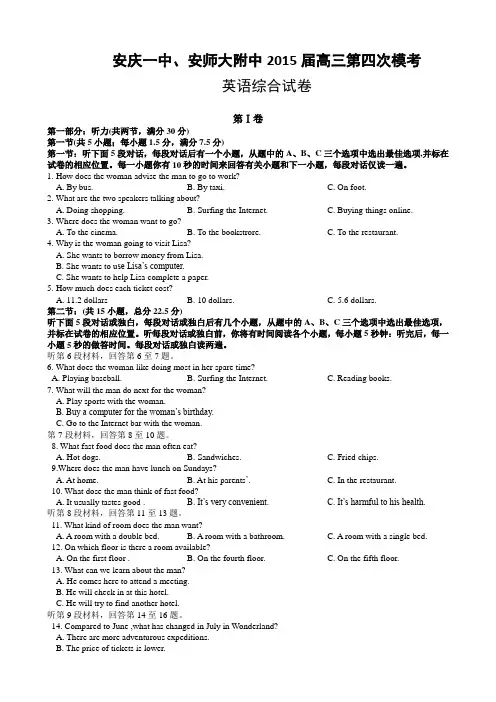
安庆一中、安师大附中2015届高三第四次模考英语综合试卷第Ⅰ卷第一部分:听力(共两节,满分30分)第一节(共5小题;每小题1.5分,满分7.5分)第一节:听下面5段对话,每段对话后有一个小题,从题中的A、B、C三个选项中选出最佳选项,并标在试卷的相应位置。
每一小题你有10秒的时间来回答有关小题和下一小题,每段对话仅读一遍。
1. How does the woman advise the man to go to work?A. By bus.B. By taxi.C. On foot.2. What are the two speakers talking about?A. Doing shopping.B. Surfing the Internet.C. Buying things online.3. Where does the woman want to go?A. To the cinema.B. To the bookstrore.C. To the restaurant.4. Why is the woman going to visit Lisa?A. She wants to borrow money from Lisa.B. She wants to u se Lisa’s computer.C. She wants to help Lisa complete a paper.5. How much does each ticket cost?A. 11.2 dollarsB. 10 dollars.C. 5.6 dollars.第二节:(共15小题,总分22.5分)听下面5段对话或独白,每段对话或独白后有几个小题,从题中的A、B、C三个选项中选出最佳选项,并标在试卷的相应位置。
听每段对话或独白前,你将有时间阅读各个小题,每小题5秒钟:听完后,每一小题5秒的做答时间。
每段对话或独白读两遍。
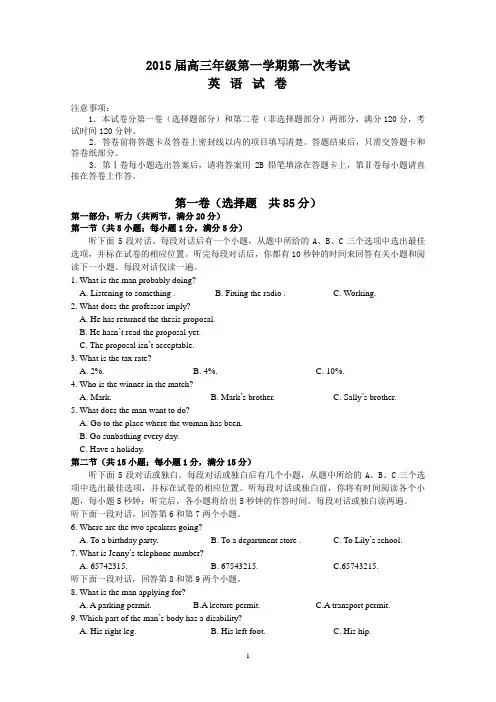
2015届高三年级第一学期第一次考试英语试卷注意事项:1.本试卷分第一卷(选择题部分)和第二卷(非选择题部分)两部分,满分120分,考试时间120分钟。
2.答卷前将答题卡及答卷上密封线以内的项目填写清楚。
答题结束后,只需交答题卡和答卷纸部分。
3.第Ⅰ卷每小题选出答案后,请将答案用2B铅笔填涂在答题卡上,第Ⅱ卷每小题请直接在答卷上作答。
第一卷(选择题共85分)第一部分:听力(共两节,满分20分)第一节(共5小题;每小题1分,满分5分)听下面5段对话。
每段对话后有一个小题,从题中所给的A、B、C三个选项中选出最佳选项,并标在试卷的相应位置。
听完每段对话后,你都有10秒钟的时间来回答有关小题和阅读下一小题。
每段对话仅读一遍。
1. What is the man probably doing?A. Listening to something .B. Fixing the radio .C. Working.2. What does the professor imply?A. He has returned the thesis proposal.B. He hasn’t read the proposal yet.C. The proposal isn’t acceptable.3. What is the tax rate?A. 2%.B. 4%.C. 10%.4. Who is the winner in the match?A. Mark.B. Mark’s brother.C. Sally’s brother.5. What does the man want to do?A. Go to the place where the woman has been.B. Go sunbathing every day.C. Have a holiday.第二节(共15小题;每小题1分,满分15分)听下面5段对话或独白。
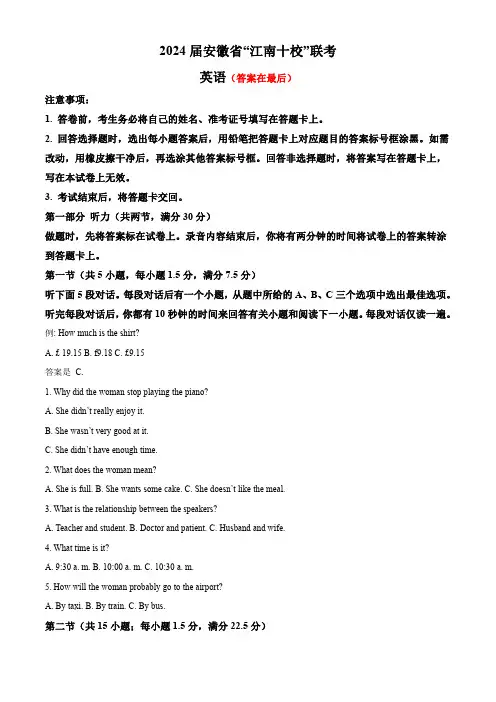
2024届安徽省“江南十校”联考英语(答案在最后)注意事项:1.答卷前,考生务必将自己的姓名、准考证号填写在答题卡上。
2.回答选择题时,选出每小题答案后,用铅笔把答题卡上对应题目的答案标号框涂黑。
如需改动,用橡皮擦干净后,再选涂其他答案标号框。
回答非选择题时,将答案写在答题卡上,写在本试卷上无效。
3.考试结束后,将答题卡交回。
第一部分听力(共两节,满分30分)做题时,先将答案标在试卷上。
录音内容结束后,你将有两分钟的时间将试卷上的答案转涂到答题卡上。
第一节(共5小题,每小题1.5分,满分7.5分)听下面5段对话。
每段对话后有一个小题,从题中所给的A、B、C三个选项中选出最佳选项。
听完每段对话后,你都有10秒钟的时间来回答有关小题和阅读下一小题。
每段对话仅读一遍。
例:How much is the shirt?A.£19.15B.f9.18C.£9.15答案是 C.1.Why did the woman stop playing the piano?A.She didn’t really enjoy it.B.She wasn’t very good at it.C.She didn’t have enough time.2.What does the woman mean?A.She is full.B.She wants some cake.C.She doesn’t like the meal.3.What is the relationship between the speakers?A.Teacher and student.B.Doctor and patient.C.Husband and wife.4.What time is it?A.9:30a.m.B.10:00a.m.C.10:30a.m.5.How will the woman probably go to the airport?A.By taxi.B.By train.C.By bus.第二节(共15小题;每小题1.5分,满分22.5分)听下面5段对话或独白。
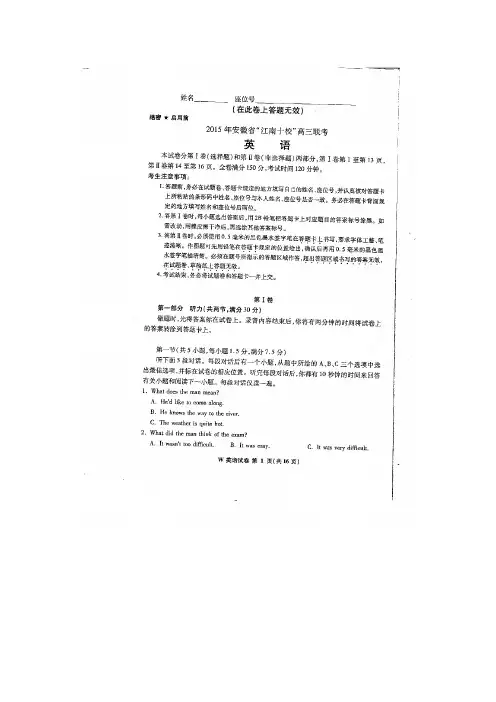
听力参考原文:1. W: Would you like to join us for a walk along the river? M: What a nice way to spend a hot day!2.W: Did you pass the exam?M: Yes, but I have never had a more difficult one in my life.3.M: I’d like to be in Xuancheng before 11:30. Is there a train at about 9:30?W: Yes, there is the 9:34. It’ll arrive there just after 11:00.4.M: I suppose I should find a doctor of my own. Could you recommend one to me?W: Well, why don’t you go to Dr. Read? He has been taking care of me these years and giving some good advice on diet.5.W: Excuse me for being late for class. My bike broke down.M: Seems bikes break down more often on Monday mornings, don’t they? Yours is the sixth one this morning. Now, go back to your seat.6.M: Hi, Mary. It’s me, Daniel.W: Oh, hi, Daniel. How are you?M: Fine. Tell me, what are you doing this afternoon?W: I’m not sure. I’ll probably stay at home and read a book.M: Well, I’m planning to go fishing. Would you like to join me?W: Sure, I’d be happy to. It sounds a lot more exciting than staying at home and reading a book. M: Great! I’ll pick you up at 1:30.W: See you then.7.M: What are you going to do after you return from Sydney?W: I’m going to stay in the city.M: What will you do all day?W: I am going to work with my father at the store. In the evening I’ll read books. At weekends, I’ll go to the beach with my family.M: Have you ever worked?W: No, but I can learn. What’re you going to do this summer?M: I’m going to camp. I’ve gone to camp for four summers.W: I’ve never gone to camp. What’re you going to do this summer?M: We do many things. In the morning, we go swimming and boating. In the afternoon, we play basketball or tennis. We sit around a campfire at night, singing and telling stories.W: That sounds wonderful.M: It is wonderful.8.M: Susan! Where have you been?W: Wait until I tell you. Richard! I’ve been downtown and I saw just what I wanted.M: I know. A green dress to match the green shoes you bought yesterday.W: No. Not a green dress or a red one or a yellow one. It isn’t anything for me. It’s for our house.M: Our house? What is it?W: You’ll never guess. It’s a new sofa. A yellow one.M: We already have a sofa, Susan. A very good one.W: I never like it. It’s brown and our other furniture is light blue. They don’t match. The yellow one will look good with other things.M: Very well. Is the new sofa wider or narrower?W: It is both.M: What do you mean?W: Well, it’s a little bit wider than our old one, but it looks narrower because it’s longer.M: Fine. Then I’ll have a very good place to sleep after dinner.9.M: Now, madam, did you get a good view of the accident?W: Oh, yes. I was standing outside Brown’s toyshop and I saw it all quite clearly.M: Do you know about what time it was?W: Yes, I checked my watch. It was 2:40 exactly.M: Good. How fast was the truck moving?W: Well, quite slowly---about 10 miles an hour. It was coming up Victoria Street and I suppose the driver realized the lights were going to change. But they were still red when he went over them.M: I see. What about the car?W: It was a red Ford. It was coming along Lincoln Avenue at about 30 miles per hour. The driver braked when he saw the truck crossing the Avenue.M: Did you see what color his traffic light was?W: Yes, it changed to yellow just before he crossed it.M: Thank you. Could you please sign your name here?10.Most Americans don’t like to get advice from members of their family. When they need adv ice, they usually don’t ask people they know. Instead, many Americans write letters to newspapers and magazines which give advice on many different subjects, including family problems, sex, the use of language, health, cooking, child care, clothes, and how to buy a house or a car.Most newspapers regularly print letters from readers with problems. Along with the letters there are answers written by people who are supposed to know how to settle such problems. Some of these writers are doctors and others are lawyers or educators. But two of the most famous writers of advice are women without special training for this kind of work. One of them answers letters addressed to “Dear Abby”. The other is addressed as “Dear Ann Landers”. Experience is their preparation for giving advice.参考答案第一部分1. A2.C3. B4.C5. A6.C7.B8.B9.C 10.B11.A 12.C 13.B 14.A 15.A 16.C 17.B 18.C 19.A 20.B第二部分21.A 22.C 23.D 24.C 25.B 26.D 27.A 28.C 29.D 30.B31.B 32.A 33.C 34.D 35.C 36.B 37.C 38.A 39.D 40.C41.A 42.B 43.D 44.B 45.D 46.A 47.C 48.B 49.A 50.C51.D 52.C 53.B 54.A 55.D第三部分56.D 57.B 58.C 59.B 60.B 61.D 62.A 63.B 64.C 65.A 66.C 67.A 68.B 69.B 70.A 71.D 72.B 73.C 74.A 75.D第四部分第一节76. possesses/ has / owns 77. evaluate / assess 78. highly 79. Qualities80. Taking 81. going 82. concerned 83. individuals84. Listen 85. encouragement第二节:One possible versionThis quotation from Charles Chaplin tells us that confidence plays a vital role in people’s life. Confidence means trust in one’s ability. Faced with difficult problems or hard tasks, we should have faith in ourselves.When I was in Junior One, nobody could imagine how hard I was struggling with my English pronunciation. Afraid of losing face before my classmates, I dared not open my mouth. I was about to give up when my teacher came to me, giving me a hand. His encouraging words lit me up and benefited me a lot. With the confidence regained, my spoken English improved greatly.In fact, everyone is unique. Nobody can replace you. A confident person can get over any hardship in study and life, because what matters is confidence, which will contribute to your success.新课标第一网系列资料。

2015安徽江南十校高三联考英语试题及答案以下2015安徽江南十校高三联考英语试题及答案由高考频道为您精心提供,希望对您有所帮助。
文章底部有word版下载地址安徽省“江南十校”2015届高三联考英语试题参考答案第一部分1. A2.C3. B4.C5. A6.C7.B8.B9.C 10.B11.A 12.C 13.B 14.A 15.A 16.C 17.B 18.C 19.A 20.B第二部分21.A 22.C 23.D 24.C 25.B 26.D 27.A 28.C 29.D 30.B31.B 32.A 33.C 34.D 35.C 36.B 37.C 38.A 39.D 40.C41.A 42.B 43.D 44.B 45.D 46.A 47.C 48.B 49.A 50.C51.D 52.C 53.B 54.A 55.D第三部分56.D 57.B 58.C 59.B 60.B 61.D 62.A 63.B 64.C 65.A 66.C 67.A 68.B 69.B 70.A 71.D 72.B 73.C 74.A 75.D第四部分第一节76. possesses/ has / owns 77. evaluate / assess 78. highly 79. Qualities80. Taking 81. going 82. concerned 83. individuals84. Listen 85. encouragement第二节:One possible versionThis quotation from Charles Chaplin tells us that confidence plays a vital role in people’s life. Confidence means trust in one’s ability. Faced with difficult problems or hard tasks, we should have faith in ourselves.When I was in Junior One, nobody could imagine how hard I was struggling with my English pronunciation. Afraid of losing face before my classmates, I dared not open my mouth. I was about to give up when my teacher came to me, giving me a hand. His encouraging words lit me up and benefited me a lot. With the confidence regained, my spoken English improved greatly.In fact, everyone is unique. Nobody can replace you. A confident person can get over any hardship in study and life, because what matters is confidence, which will contribute to your success.听力参考原文:1. W: Would you like to join us for a walk along the river?M: What a nice way to spend a hot day!2. W: Did you pass the exam?M: Yes, but I have never had a more difficult one in my life.3. M: I’d like to be in Xuancheng before 11:30. Is there a train at about 9:30?W: Yes, there is the 9:34. It’ll arrive there just after 11:00.4. M: I suppose I should find a doctor of my own. Could you recommend one to me?W: Well, why don’t you go to Dr. Read? He has been taking care of me these years and giving some good advice on diet.5. W: Excuse me for being late for class. My bike broke down.M: Seems bikes break down more often on Monday mornings, don’t they? Yours is thesixth one this morning. Now, go back to your seat.6. M: Hi, Mary. It’s me, Daniel.W: Oh, hi, Daniel. How are you?M: Fine. Tell me, what are you doing this afternoon?W: I’m not sure. I’ll probably stay at home and read a book.M: Well, I’m planning to go fishing. Would you like to join me?W: Sure, I’d be happy to. It sounds a lot more exciting than staying at home and reading a book.M: Great! I’ll pick you up at 1:30.W: See you then.7. M: What are you going to do after you return from Sydney?W: I’m going to stay in the city.M: What will you do all day?W: I am going to work with my father at the store. In the evening I’ll read books. At weekends, I’ll go to the beach with my family.M: Have you ever worked?W: No, but I can learn. What’re you going to do this summer?M: I’m going to camp. I’ve gone to camp for four summers.W: I’ve never gone to camp. What’re you going to do this summer?M: We do many things. In the morning, we go swimming and boating. In the afternoon, we play basketball or tennis. We sit around a campfire at night, singing and telling stories.W: That sounds wonderful.M: It is wonderful.8. M: Susan! Where have you been?W: Wait until I tel l you. Richard! I’ve been downtown and I saw just what I wanted.M: I know. A green dress to match the green shoes you bought yesterday.W: No. Not a green dress or a red one or a yellow one. It isn’t anything for me. It’s for our house.M: Our house? What is it?W: You’ll never guess. It’s a new sofa. A yellow one.M: We already have a sofa, Susan. A very good one.W: I never like it. It’s brown and our other furniture is light blue. They don’t match. The yellow one will look good with other things.M: Very well. Is the new sofa wider or narrower?W: It is both.M: What do you mean?W: Well, it’s a little bit wider than our old one, but it looks narrower because it’s longer.M: Fine. Then I’ll have a very good place to sleep after dinner.9. M: Now, madam, did you get a good view of the accident?W: Oh, yes. I was standing outside Brown’s toyshop and I saw it all quite clearly.M: Do you know about what time it was?W: Yes, I checked my watch. It was 2:40 exactly.M: Good. How fast was the truck moving?W: Well, quite slowly---about 10 miles an hour. It was coming up Victoria Street and I suppose the driver realized the lights were going to change. But they were still red when he went over them.M: I see. What about the car?W: It was a red Ford. It was coming along Lincoln Avenue at about 30 miles per hour. The driver braked when he saw the truck crossing the Avenue.M: Did you see what color his traffic light was?W: Yes, it changed to yellow just before he crossed it.M: Thank you. Could you please sign your name here?10. Most Americans don’t like to get advice from membersof their family. When they need advice, they usually don’t ask people they know. Instead, many Americans write letters to newspapers and magazines which give advice on many different subjects, including family problems, sex, the use of language, health, cooking, child care, clothes, and how to buy a house or a car.Most newspapers regularly print letters from readers with problems. Along with the letters there are answers written by people who are supposed to know how to settle such problems. Some of these writers are doctors and others are lawyers or educators. But two of the most famous writers of advice are women without special training for this kind of work. One of them answers lett ers addressed to “Dear Abby”. The other is addressed as “Dear Ann Landers”. Experience is their preparation for giving advice.点击下载:安徽省“江南十校”2015届高三联考英语试题。
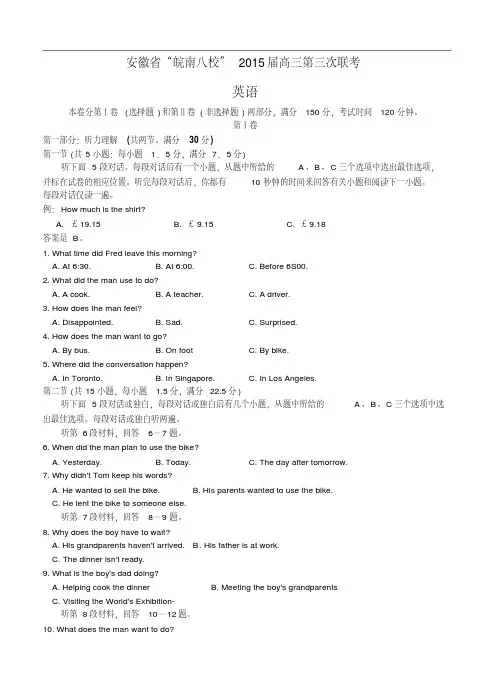
安徽省“皖南八校”2015届高三第三次联考英语本卷分第Ⅰ卷(选择题)和第Ⅱ卷(非选择题)两部分,满分150分,考试时间120分钟。
第Ⅰ卷第一部分:听力理解(共两节。
满分30分)第一节(共5小题:每小题1.5分,满分7.5分)听下面5段对话。
每段对话后有一个小题,从题中所给的A、B、C三个选项中选出最佳选项,并标在试卷的相应位置。
听完每段对话后,你都有10秒钟的时间来回答有关小题和阅读下一小题。
每段对话仅读一遍。
例:How much is the shirt?A. £19.15B. £9.15C. £9.18答案是B。
1. What time did Fred leave this morning?A. At 6:30.B. At 6:00.C. Before 6S00.2. What did the man use to do?A. A cook.B. A teacher.C. A driver.3. How does the man feel?A. Disappointed.B. Sad.C. Surprised.4. How does the man want to go?A. By bus.B. On footC. By bike.5. Where did the conversation happen?A. In Toronto.B. In Singapore.C. In Los Angeles.第二节(共15小题,每小题 1.5分,满分22.5分)听下面5段对话或独白,每段对话或独白后有几个小题,从题中所给的A、B、C三个选项中选出最佳选项。
每段对话或独白听两遍。
听第6段材料,回答6—7题。
6. When did the man plan to use the bike?A. Yesterday.B. Today.C. The day after tomorrow.7. Why didn't Tom keep his words?A. He wanted to sell the bike.B. His parents wanted to use the bike.C. He lent the bike to someone else.听第7段材料,回答8—9题。
安徽省安庆市五校联盟2015届高三英语下学期3月联考试题第一部分:听力(共两节,满分30分)第一节(共5小题;每小题1.5分,满分7.5分)听下面5段对话。
每段对话后有一个小题,从题中所给的A、B、C三个选项中选出最佳选项,听完每段对话后,你都有10秒钟的时间来回答有关小题和阅读下一小题,每段对话仅读一遍。
1. How much did the food and drinks cost?A. $30.B. $20.C. $10.2. What does the man probably think of the woman?A. She is careless.B. She is a good student.C. She is old-fashioned.3. Where does the conversation probably take place?A. In a supermarket.B. In a restaurant.C. In a cafeteria.4. Who is the man talking to?A. His sister.B. Maria.C. Sofia.5. What does the man need a suit for?A. A dance party.B. A job interview.C. A business trip.第二节(共15小题;每小题1.5分,满分22.5分)听下面5段对话或独白。
每段对话或独白后有几个小题。
从题中所给的A、B、C三个选项中选出最佳选项。
听每段对话或独白前,你将有时间阅读各个小题,每小题5秒钟;听完后,各小题将给出5秒钟的作答时间,每段对话或独白读两遍。
听第6段材料,回答第6至7题。
6. What do we know about the writer?A. He was an assistant years ago.B. He was born disabled.C. He is a child.7. How does the man feel about the writer?A. Impressed.B. Suspected.C. Delighted.听第7段材料,回答第8至9题。
8. What is the problem for the woman?A. She failed an important test.B. She needs to learn more English.C. Sh e can’t understand her subjects at all.9. What does the man say at the end of the conversation?A. The woman should quit trying.B. The woman is doing a good job.C. The woman is paying too much for her lessons.听第8段材料,回答第10至12题。
10. How did the man get the car probably?A. He bought it from another person.B. He made it by himself.C. He bought it from a car store.11. What does the price of the car include?A. A one-month service agreement.B. Free service for one year.C. All fees but no taxes.12. What will the man probably do next?A. Test out the car by himself.B. Get the car keys for the woman.C. Get the money ready to pay.听第9段材料,回答第13至16题。
13. Where does the conversation probably take place?A. In a small classroom.B. In a large lecture hall.C. In a professor’s office.14. What is no longer part of the course?A. Weekly tests.B. Monthly reports.C. The midterm exam.15. What should be discussed with the woman in advance?A. Where to do the research.B. Certain paper topics.C. Films used as sources.16. What is true about the term papers?A. They are due in four months.B. They must be at least ten pages.C. They can focus on any period in history.听第10段材料,回答第17至20题。
17. What does Jabbar look like?A. He is tall.B. He is thin.C. He is heavy.18. How fast can Jabbar run?A. About 35 miles per hour.B. About 40 miles per hour.C. About 50 miles per hour.19. What can we infer about Jabbar?A. He is usually outgoing.B. He can eat too much.C. He comes from New York.20. Who might the speaker be?A. An animal keeper.B. A tourist.C. A host.第二部分:词汇知识运用(共两节,满分45分)第一节:单项选择(共15小题;每小题1分,满分15分)从所给各题的A、B、C、D四个选项中,选出可以填入空白处的最佳选项。
21. — My daughter is a volunteer and often helps the disabled.—______ . They’re really something.A. So are theyB. So is my sonC. So do theyD. So it is with my son22. — ______ it snow tomorrow, what would we do?—In that case, we’ll have to stay at home.A. WillB. ShouldC. MightD. Can23. I believe the world is ______ you think it is. So smile at the world and it will smile back.A. whatB. howC. thatD. which24. — What do you do as a volunteer in Africa?— ______ ! There are many poor people there, who need a lot of help.A. LittleB. EverythingC. NoneD. Something25. There are 12 fantastic lamps hanging ______ the ceiling in the restaurant.A. onB. aroundC. inD. from26. People would like to listen to officials talk ______ , for no one likes an endless and empty talk.A. seriouslyB. fluentlyC. plainlyD. frequently27. — I was very angry with Kelvin yesterday.— I know your feelings, but if you forgive him, you ______ a bigger man.A. will beB. have beenC. would beD. were28. Sorry to have kept you waiting so long, but it’ll still be some time ______ Mr. Smith is available.A. whenB. beforeC. afterD. since29. Ning Zetao, who won four golds at the 2014 Incheon Asian Games, ______ himself as a new swim star.A. consideredB. developedC. distinguishedD. represented30. There are more than 740 million Chinese ______ to second-hand smoking in public places now.A. are being exposedB. to exposeC. having been exposedD. exposed31. Making a speech in front of a crowd of people is not his strength but he ______ it with his heart and efforts.A. takes advantage ofB. makes up for D. 1ives up toC. gets hold of32. China marked its first Constitution Day on December 4, 2014 ______ making theConstitution part of Chinese people’s daily life.A. in the hope ofB. in the form ofC. in honor ofD. in terms of33. So touching ______ that I couldn’t hold my tears back when I heard it for the first time.A. the song had soundedB. had the song soundedC. the song soundedD. did the song sound34. ______ around the clock for two days,David managed to finish the report for the manager on schedule.A. WorkingB. WorkedC. Having workedD. To work35. — Wow,you won first in the stow-telling competition. Fantastic!—______ !A. Give me fiveB. CongratulationsC. That’s all rightD. Forget it第二节:完形填空(共20小题;每小题1.5分,满分30分)阅读下面短文,从短文后所给各题的A、B、C和D四个选项中,选出可以填入空白处的最佳选项。